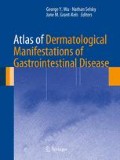Abstract
Clinical signs and features include:
Bimodal incidence pattern—childhood and then age 50–70s; four to ten new cases per million; more common in women
Associated with internal malignancy in about 25 % of cases, especially adenocarcinoma of ovary, lung, and gastrointestinal tract in Western countries and nasopharyngeal carcinomas in South East Asia, Southern China, and North Africa; the diagnosis of dermatomyositis may be made prior to, concurrently, or after the diagnosis of malignancy; age-appropriate malignancy surveillance is recommended
Muscle symptoms: symmetric proximal muscle and truncal weakness that develops relatively slowly over the course of weeks to months, occasionally associated with myalgias and muscle tenderness early in the disease course. It is atypical for muscle disease to precede skin manifestations.
Access this chapter
Tax calculation will be finalised at checkout
Purchases are for personal use only
References
Khan S, Christopher-Stine L. Polymyositis, dermatomyositis, and autoimmune necrotizing myopathy: clinical features. Rheum Dis Clin North Am. 2011;37:143–58.
Ramos-E-Silva M, Carvalho JC, Carneiro SC. Cutaneous paraneoplasia. Clin Dermatol. 2011;29:541–7.
Zahr ZA, Baer AN. Malignancy in myositis. Curr Rheumatol Rep. 2011;13:208–15.
Nagaraju K, Lundberg IE. Polymyositis and dermatomyositis: pathophysiology. Rheum Dis Clin North Am. 2011;37:159–71.
Marie I, Mouthon L. Therapy of polymyositis and dermatomyositis. Autoimmun Rev. 2011;11:6–13.
Rowin J, Amato AA, Deisher N, et al. Mycophenolate mofetil in dermatomyositis: is it safe? Neurology. 2006;66:1245–7.
Dawkins MA, Jorizzo JL, Walker FO, et al. Dermatomyositis. A dermatology-based case series. J Am Acad Dermatol. 1998;38:397–404.
Kim JE, Jeong MG, Lee HE, et al. Successful treatment of cutaneous lesions of dermatomyositis with topical pimecrolimus. Ann Dermatol. 2011;23:348–51.
Author information
Authors and Affiliations
Corresponding author
Editor information
Editors and Affiliations
Rights and permissions
Copyright information
© 2013 Springer Science+Business Media New York
About this chapter
Cite this chapter
Zakko, L., Finch, J., Rothe, M.J., Grant-Kels, J.M. (2013). Dermatomyositis: Dermatological Features. In: Wu, G., Selsky, N., Grant-Kels, J. (eds) Atlas of Dermatological Manifestations of Gastrointestinal Disease. Springer, New York, NY. https://doi.org/10.1007/978-1-4614-6191-3_14
Download citation
DOI: https://doi.org/10.1007/978-1-4614-6191-3_14
Published:
Publisher Name: Springer, New York, NY
Print ISBN: 978-1-4614-6190-6
Online ISBN: 978-1-4614-6191-3
eBook Packages: MedicineMedicine (R0)

